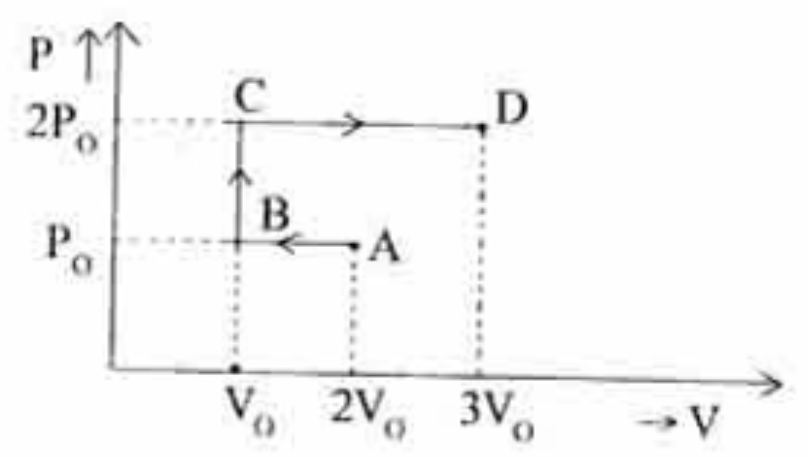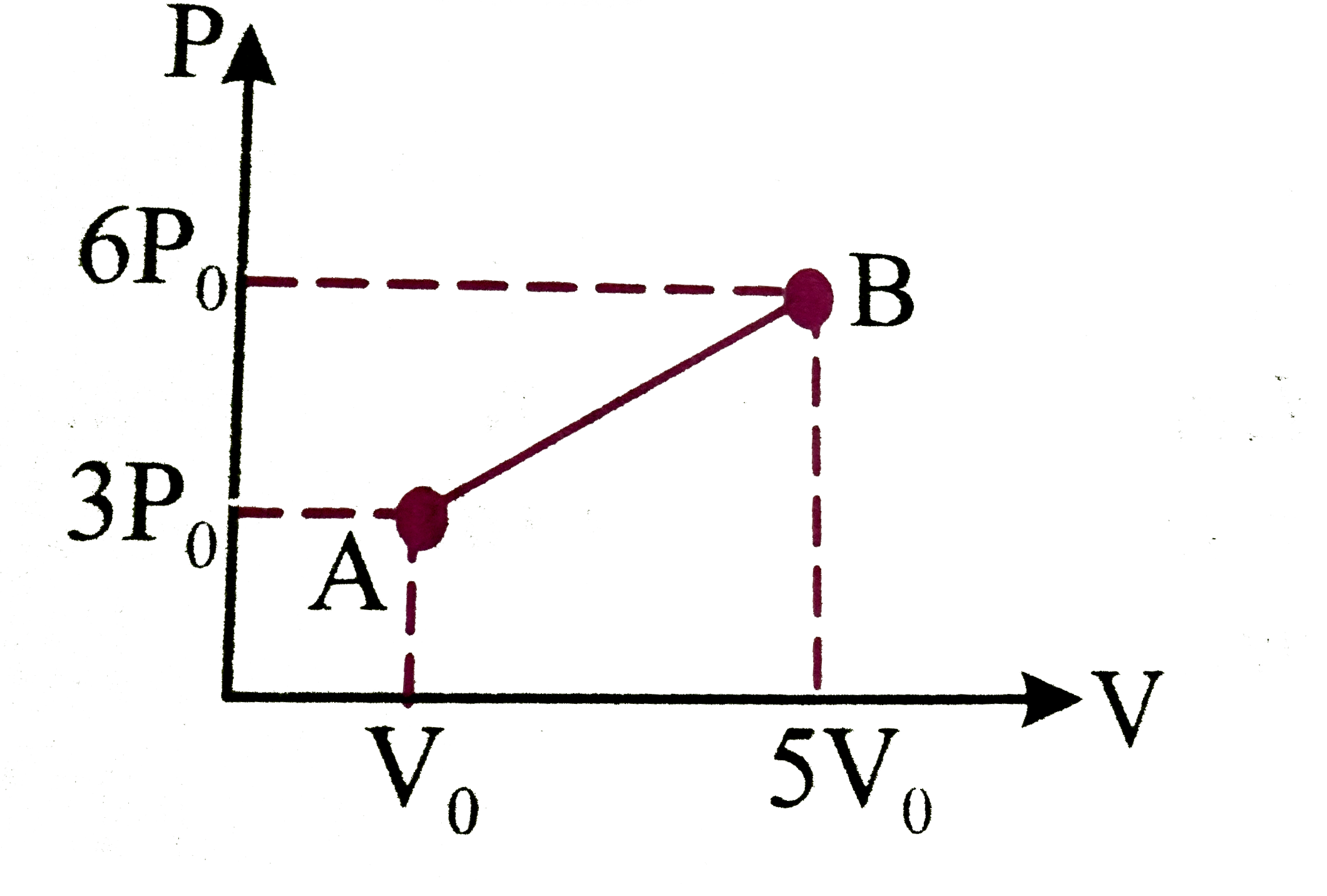If the boundary of system moves by an infinitesimal amount, the work involved is given by
for irreversible process
for reversible process
so for reversible isothermal process
2mole of an ideal gas undergoes isothermal compression along three different plaths :
(i) reversible compression from bar and to bar
(ii) a single stage compression against a constant external pressure of 20 bar, and
(iii) a two stage compression consisting initially of compression against a constant external pressure of 10 bar until , followed by compression against a constant pressure of 20 bar until
Work done on the gas in single stage compression is :
36
72
144
None of these
The correct Answer is:C
To solve the problem of work done on the gas during a single-stage compression against a constant external pressure of 20 bar, we will follow these steps:
Step 1: Understand the Work Done Formula
For an irreversible process where the gas is compressed against a constant external pressure, the work done (w) can be expressed as:
w=−PextΔV
where ΔV=Vf−Vi.
Step 2: Identify Initial and Final Conditions
Given:
- Initial Pressure Pi=2 bar
- Initial Volume Vi=8 L
- Final Pressure Pf=20 bar
- External Pressure Pext=20 bar
Step 3: Calculate Initial Conditions
Using the ideal gas equation PV=nRT:
- For the initial state:
PiVi=nRT⟹2bar×8L=2moles×R×T
Converting pressure from bar to atm (1 bar = 0.98692 atm):
2bar≈1.972atm
So,
1.972×8=2RT
This gives us the product RT.
Step 4: Calculate Final Volume
Using the final pressure:
PfVf=nRT⟹20bar×Vf=2RT
Converting Pf to atm:
20bar≈19.44atm
Thus,
19.44×Vf=2RT
Step 5: Relate Initial and Final Volumes
From the equations:
1. 1.972×8=2RT
2. 19.44×Vf=2RT
Equating the two:
1.972×8=19.44×Vf
Solving for Vf:
Vf=1.972×819.44
Step 6: Calculate ΔV
Now calculate ΔV:
ΔV=Vf−Vi
Substituting Vi=8L and the calculated Vf.
Step 7: Calculate Work Done
Now substitute ΔV into the work done formula:
w=−PextΔV
Substituting Pext=20bar and the calculated ΔV.
Step 8: Final Calculation
Calculate the final value of work done w.
Final Answer
The work done on the gas during the single-stage compression is calculated as per the above steps.
For an irreversible process where the gas is compressed against a constant external pressure, the work done (w) can be expressed as:
w=−PextΔV
where ΔV=Vf−Vi.
Given:
- Initial Pressure Pi=2 bar
- Initial Volume Vi=8 L
- Final Pressure Pf=20 bar
- External Pressure Pext=20 bar
Using the ideal gas equation PV=nRT:
- For the initial state:
PiVi=nRT⟹2bar×8L=2moles×R×T
Converting pressure from bar to atm (1 bar = 0.98692 atm):
2bar≈1.972atm
So,
1.972×8=2RT
This gives us the product RT.
Using the final pressure:
PfVf=nRT⟹20bar×Vf=2RT
Converting Pf to atm:
20bar≈19.44atm
Thus,
19.44×Vf=2RT
From the equations:
1. 1.972×8=2RT
2. 19.44×Vf=2RT
1.972×8=19.44×Vf
Solving for Vf:
Vf=1.972×819.44
Now calculate ΔV:
ΔV=Vf−Vi
Substituting Vi=8L and the calculated Vf.
Now substitute ΔV into the work done formula:
w=−PextΔV
Substituting Pext=20bar and the calculated ΔV.
Calculate the final value of work done w.
The work done on the gas during the single-stage compression is calculated as per the above steps.
Topper's Solved these Questions
Similar Questions
If the boundary of system moves by an infinitesimal amount, the work involved is given by dw=−PextdV
for irreversible process w=−PextΔV (where ΔV=Vf−Vi)
for reversible process Pext=Pint±dP≅Pint
so for reversible isothermal process w=−nRTln.VfVi
2mole of an ideal gas undergoes isothermal compression along three different paths :
(i) reversible compression from Pi=2 bar and Vi=8L to Pf=20 bar
(ii) a single stage compression against a constant external pressure of 20 bar, and
(iii) a two stage compression consisting initially of compression against a constant external pressure of 10 bar until Pgas=Pext, followed by compression against a constant pressure of 20 bar until Pgas=Pext
Order of magnitude of work is :
View SolutionIf the boundary of system moves by an infinitesimal amount, the work involved is given by dw=−PextdV
for irreversible process w=−PextΔV (where ΔV=Vf−Vi)
for reversible process Pext=Pint±dP≅Pint
so for reversible isothermal process w=−nRTln.VfVi
2mole of an ideal gas undergoes isothermal compression along three different plaths :
(i) reversible compression from Pi=2 bar and Vi=8L to Pf=20 bar
(ii) a single stage compression against a constant external pressure of 20 bar, and
(iii) a two stage compression consisting initially of compression against a constant external pressure of 10 bar until Pgas=Pext, followed by compression against a constant pressure of 20 bar until Pgas=Pext
Work done (in bar-L) on the gas in reversible isothermal compression is :
View SolutionIf the boundary of system moves by an infinitesimal amount, the work involved is given by dw=−PextdV
for irreversible process w=−PextΔV (where ΔV=Vf−Vi)
for reversible process Pext=Pint±dP≅Pint
so for reversible isothermal process w=−nRTln.VfVi
2mole of an ideal gas undergoes isothermal compression along three different plaths :
(i) reversible compression from Pi=2 bar and Vi=8L to Pf=20 bar
(ii) a single stage compression against a constant external pressure of 20 bar, and
(iii) a two stage compression consisting initially of compression against a constant external pressure of 10 bar until Pgas=Pext, followed by compression against a constant pressure of 20 bar until Pgas=Pext
Total work done on the gas in two stage compression is :
View SolutionThe work done by the gas in the process shown in given P-V diagram is

View SolutionOne mole of a monoatomic ideal gas undergoes the process A→B in the given P-V diagram. What is the specific heat for this process?

View SolutionA sample of gas is compressed from an initial volume of 2v0 to v0 using three different processes.
First: Using reversible isothermal
Second: Using reversible adiabatic
Third: Using irreversible adiabatic under a constant external pressure then
View SolutionFor a reversible process at T = 300K, the volume is increased from Vi=1L to Vf=10L. Calculate ΔH if the process is isothermal -
View SolutionA gas is expanded from volume V1 to V2 through three different process:
a. Reversible adiabatic
b. Reversible isothermal
c. Irreversible adiabatic (against a constant external pressure Pex)
The correct option is
View SolutionTwo moles of an ideal gas undergo the following process :
(a) a reversible isobaric expansion from (P atm, VL) to (P atm , 2VL).
(b) a reversible isochoric change of state from (P atm , 2V,L) to (P/2 atm, 2VL)
(c) a reversible isothermal compression from (P/2 atm, 2VL) to (P atm, VL).
Sketch with labels each of the processes on the same P−V diagram.
View SolutionA sample of ideal gas undergoes isothermal expansion in a reversible manner from volume V1 to volume V2. The initial pressure is P1 and the final pressure is P2. The same sample is then allowed to undergoes reversible expansion under adiabatic conditions from volume V1→V2. The initial pressure being same but final pressure is P2.
If P3 and P2 are equal, then
View Solution